An Analysis of Contemporary Accounting Issues: Charter Hall Group
VerifiedAdded on 2020/04/15
|16
|2265
|258
Report
AI Summary
This report provides a detailed analysis of Charter Hall Group's financial reporting practices, focusing on its compliance with the Conceptual Framework for Financial Reporting. The study examines how Charter Hall Group meets the objectives of the framework, including providing useful information for decision-making and reporting on future cash flows and organizational resources. The report also assesses the company's adherence to recognition criteria for assets, liabilities, equity, revenue, and expenses, as well as its satisfaction of the fundamental qualitative characteristics of relevance, faithful representation, comparability, verifiability, timeliness, and understandability. The analysis draws on Charter Hall Group's annual reports and relevant accounting standards (AASB, IFRS, IASB, and Corporation Act 2001) to evaluate the quality and transparency of its financial reporting.

Running head: CONTEMPORARY ISSUES IN ACCOUNTING
Contemporary Issues in Accounting
Name of the Student
Name of the University
Author’s Note
Contemporary Issues in Accounting
Name of the Student
Name of the University
Author’s Note
Paraphrase This Document
Need a fresh take? Get an instant paraphrase of this document with our AI Paraphraser

1CONTEMPORARY ISSUES IN ACCOUNTING
Abstract
This study takes an honest attempt to analyze different aspects of the compliance of Conceptual
Framework for Financial Reporting by Charter Hall Group. First part of this report shows the
compliance with main objectives of conceptual framework by Charter Hall Group. In the second
part, discussion shows the recognition of major financial aspects by Charter Hall Group. The last
part shows the satisfaction of major qualitative characteristics of conceptual framework by
Charter Hall Group for enhancing the quality of financial reporting.
Abstract
This study takes an honest attempt to analyze different aspects of the compliance of Conceptual
Framework for Financial Reporting by Charter Hall Group. First part of this report shows the
compliance with main objectives of conceptual framework by Charter Hall Group. In the second
part, discussion shows the recognition of major financial aspects by Charter Hall Group. The last
part shows the satisfaction of major qualitative characteristics of conceptual framework by
Charter Hall Group for enhancing the quality of financial reporting.
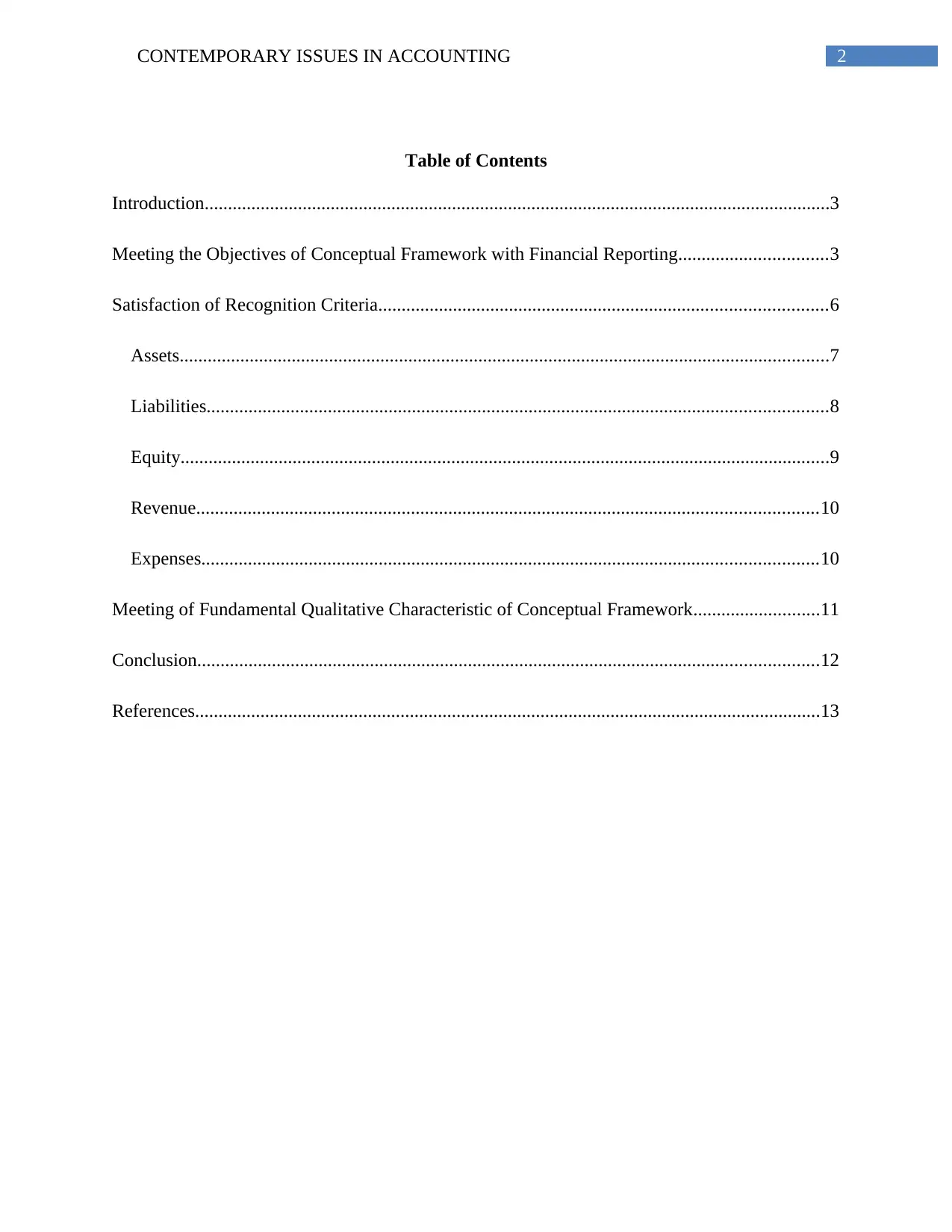
2CONTEMPORARY ISSUES IN ACCOUNTING
Table of Contents
Introduction......................................................................................................................................3
Meeting the Objectives of Conceptual Framework with Financial Reporting................................3
Satisfaction of Recognition Criteria................................................................................................6
Assets...........................................................................................................................................7
Liabilities.....................................................................................................................................8
Equity...........................................................................................................................................9
Revenue.....................................................................................................................................10
Expenses....................................................................................................................................10
Meeting of Fundamental Qualitative Characteristic of Conceptual Framework...........................11
Conclusion.....................................................................................................................................12
References......................................................................................................................................13
Table of Contents
Introduction......................................................................................................................................3
Meeting the Objectives of Conceptual Framework with Financial Reporting................................3
Satisfaction of Recognition Criteria................................................................................................6
Assets...........................................................................................................................................7
Liabilities.....................................................................................................................................8
Equity...........................................................................................................................................9
Revenue.....................................................................................................................................10
Expenses....................................................................................................................................10
Meeting of Fundamental Qualitative Characteristic of Conceptual Framework...........................11
Conclusion.....................................................................................................................................12
References......................................................................................................................................13
⊘ This is a preview!⊘
Do you want full access?
Subscribe today to unlock all pages.

Trusted by 1+ million students worldwide

3CONTEMPORARY ISSUES IN ACCOUNTING
Introduction
Conceptual Framework for Financial Reporting is considered as a base to prepare the
financial statements of the companies (Cheng et al. 2014). Conceptual framework for financial
reporting helps business organizations to tackle different issues related to financial reporting like
major objectives and uses of financial statements, the usefulness of various accounting
information, the basis for preparing financial statements and many others (Rankin et al. 2012). In
the year 1989, the International Accounting Standard Board (IASB) issued a specific framework
to prepare and present the organizational financial statements. This particular framework is
known as Conceptual Framework for Financial Reporting (Abeysekera 2013). The main aim of
this report is to make analysis and evaluation on the compliance of conceptual framework by one
of the Australian companies. For this report, Charter Hall Group is selected. Charter Hall Group
was founded in the year of 1991 and is considered as one of Australia’s leading property group.
The company has a property portfolio of $20.4 billion. Charter Hall Group was listed in
Australian Stock Exchange (ASX) in the year of 2005 and the code name of the company in
ASX is CHC (charterhall.com.au 2017). This report aims to examine the adherence of Charter
Hall Group with various aspects of conceptual framework for financial reporting.
Meeting the Objectives of Conceptual Framework with Financial Reporting
Above discussion shows that conceptual framework is an important aspect to prepare of
financial statements for companies. According to the annual report of Charter Hall Group, it can
be observed that the company follows the rules and regulations of Australian Accounting
Standard Board (AASB) as the conceptual framework for financial reporting (aasb.gov.au 2017).
In addition, Charter Hall Group also follows the standards and principles of Corporation Act
Introduction
Conceptual Framework for Financial Reporting is considered as a base to prepare the
financial statements of the companies (Cheng et al. 2014). Conceptual framework for financial
reporting helps business organizations to tackle different issues related to financial reporting like
major objectives and uses of financial statements, the usefulness of various accounting
information, the basis for preparing financial statements and many others (Rankin et al. 2012). In
the year 1989, the International Accounting Standard Board (IASB) issued a specific framework
to prepare and present the organizational financial statements. This particular framework is
known as Conceptual Framework for Financial Reporting (Abeysekera 2013). The main aim of
this report is to make analysis and evaluation on the compliance of conceptual framework by one
of the Australian companies. For this report, Charter Hall Group is selected. Charter Hall Group
was founded in the year of 1991 and is considered as one of Australia’s leading property group.
The company has a property portfolio of $20.4 billion. Charter Hall Group was listed in
Australian Stock Exchange (ASX) in the year of 2005 and the code name of the company in
ASX is CHC (charterhall.com.au 2017). This report aims to examine the adherence of Charter
Hall Group with various aspects of conceptual framework for financial reporting.
Meeting the Objectives of Conceptual Framework with Financial Reporting
Above discussion shows that conceptual framework is an important aspect to prepare of
financial statements for companies. According to the annual report of Charter Hall Group, it can
be observed that the company follows the rules and regulations of Australian Accounting
Standard Board (AASB) as the conceptual framework for financial reporting (aasb.gov.au 2017).
In addition, Charter Hall Group also follows the standards and principles of Corporation Act
Paraphrase This Document
Need a fresh take? Get an instant paraphrase of this document with our AI Paraphraser
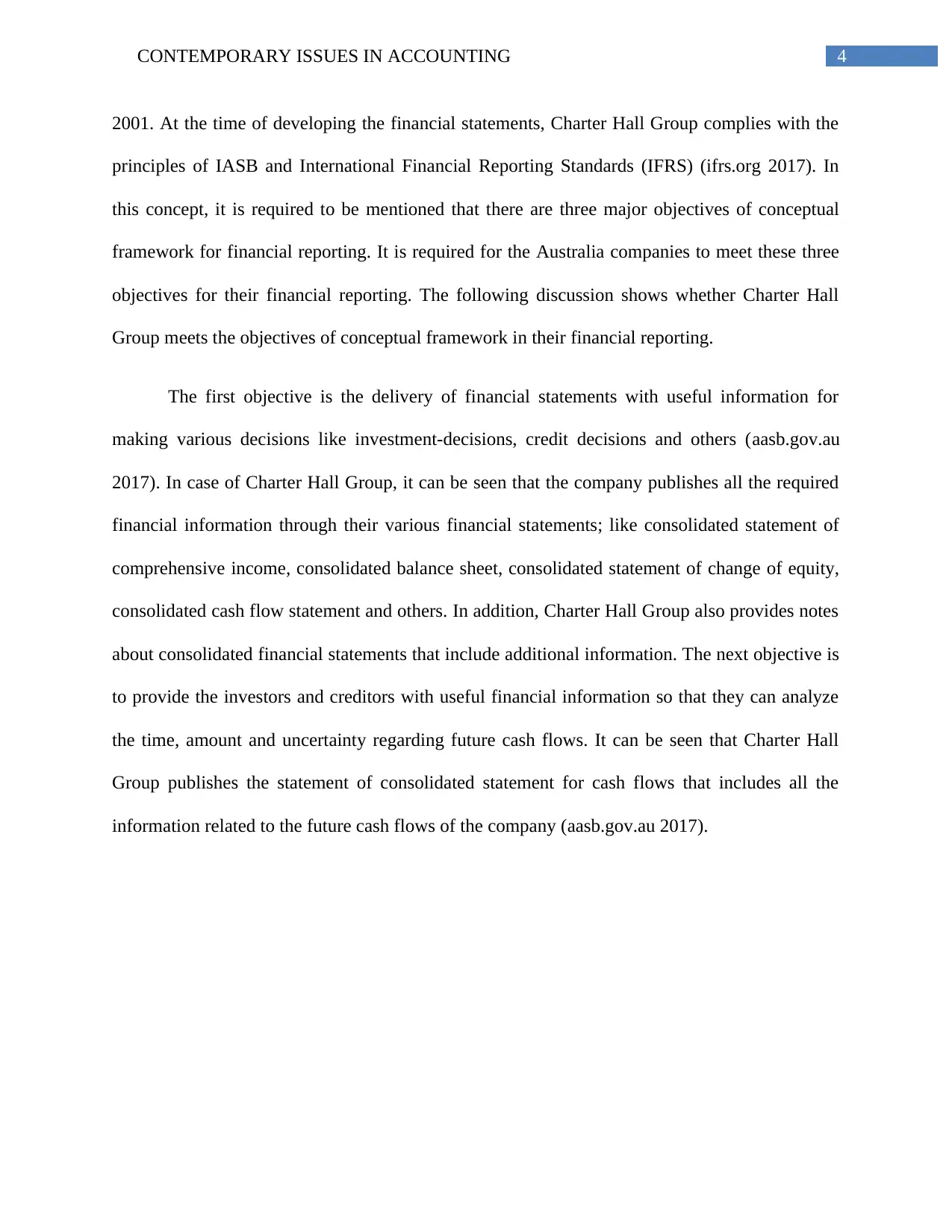
4CONTEMPORARY ISSUES IN ACCOUNTING
2001. At the time of developing the financial statements, Charter Hall Group complies with the
principles of IASB and International Financial Reporting Standards (IFRS) (ifrs.org 2017). In
this concept, it is required to be mentioned that there are three major objectives of conceptual
framework for financial reporting. It is required for the Australia companies to meet these three
objectives for their financial reporting. The following discussion shows whether Charter Hall
Group meets the objectives of conceptual framework in their financial reporting.
The first objective is the delivery of financial statements with useful information for
making various decisions like investment-decisions, credit decisions and others (aasb.gov.au
2017). In case of Charter Hall Group, it can be seen that the company publishes all the required
financial information through their various financial statements; like consolidated statement of
comprehensive income, consolidated balance sheet, consolidated statement of change of equity,
consolidated cash flow statement and others. In addition, Charter Hall Group also provides notes
about consolidated financial statements that include additional information. The next objective is
to provide the investors and creditors with useful financial information so that they can analyze
the time, amount and uncertainty regarding future cash flows. It can be seen that Charter Hall
Group publishes the statement of consolidated statement for cash flows that includes all the
information related to the future cash flows of the company (aasb.gov.au 2017).
2001. At the time of developing the financial statements, Charter Hall Group complies with the
principles of IASB and International Financial Reporting Standards (IFRS) (ifrs.org 2017). In
this concept, it is required to be mentioned that there are three major objectives of conceptual
framework for financial reporting. It is required for the Australia companies to meet these three
objectives for their financial reporting. The following discussion shows whether Charter Hall
Group meets the objectives of conceptual framework in their financial reporting.
The first objective is the delivery of financial statements with useful information for
making various decisions like investment-decisions, credit decisions and others (aasb.gov.au
2017). In case of Charter Hall Group, it can be seen that the company publishes all the required
financial information through their various financial statements; like consolidated statement of
comprehensive income, consolidated balance sheet, consolidated statement of change of equity,
consolidated cash flow statement and others. In addition, Charter Hall Group also provides notes
about consolidated financial statements that include additional information. The next objective is
to provide the investors and creditors with useful financial information so that they can analyze
the time, amount and uncertainty regarding future cash flows. It can be seen that Charter Hall
Group publishes the statement of consolidated statement for cash flows that includes all the
information related to the future cash flows of the company (aasb.gov.au 2017).

5CONTEMPORARY ISSUES IN ACCOUNTING
The last major objective of conceptual framework is to provide the users with necessary
information regarding various resources of the organizations. Balance sheet is such a statement
that discloses the necessary information regarding the organizational resources. In case of
Charter Hall Group, it can be observed that the company publishes their balance sheet on yearly
basis that has all the information regarding their resources (aasb.gov.au 2017).
The last major objective of conceptual framework is to provide the users with necessary
information regarding various resources of the organizations. Balance sheet is such a statement
that discloses the necessary information regarding the organizational resources. In case of
Charter Hall Group, it can be observed that the company publishes their balance sheet on yearly
basis that has all the information regarding their resources (aasb.gov.au 2017).
⊘ This is a preview!⊘
Do you want full access?
Subscribe today to unlock all pages.

Trusted by 1+ million students worldwide
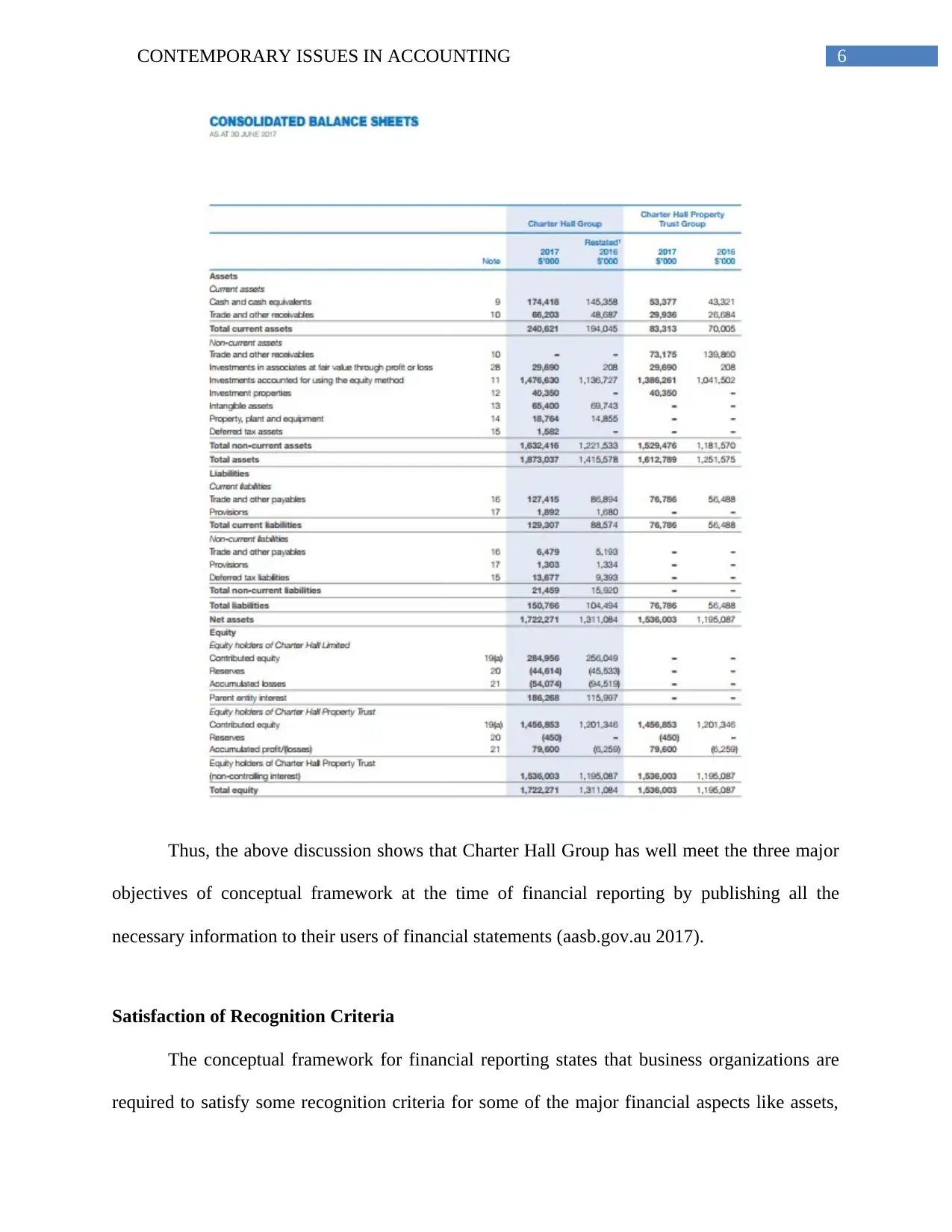
6CONTEMPORARY ISSUES IN ACCOUNTING
Thus, the above discussion shows that Charter Hall Group has well meet the three major
objectives of conceptual framework at the time of financial reporting by publishing all the
necessary information to their users of financial statements (aasb.gov.au 2017).
Satisfaction of Recognition Criteria
The conceptual framework for financial reporting states that business organizations are
required to satisfy some recognition criteria for some of the major financial aspects like assets,
Thus, the above discussion shows that Charter Hall Group has well meet the three major
objectives of conceptual framework at the time of financial reporting by publishing all the
necessary information to their users of financial statements (aasb.gov.au 2017).
Satisfaction of Recognition Criteria
The conceptual framework for financial reporting states that business organizations are
required to satisfy some recognition criteria for some of the major financial aspects like assets,
Paraphrase This Document
Need a fresh take? Get an instant paraphrase of this document with our AI Paraphraser

7CONTEMPORARY ISSUES IN ACCOUNTING
liabilities, revenues, expenses and equity. As per the criteria, there needs to be relevant
information about these aspects in the financial statements; they are needed to be faithfully
represented; and they need to be beneficial for various decision-making process of the investors
and creditors (aasb.gov.au 2017). The recognition criteria for Charter Hall Group are discussed
below:
Assets
Plant and equipment is recorder in the financial statements by deducting depreciation
from historical costs. Charter Hall Group follows the principle of AASB 9 Financial Instruments
for recognizing assets (aasb.gov.au 2017). The costs related to the assets are recognized when the
company gets the assurance of their future benefits in their cash flows (charterhall.com.au 2017).
In case of investments, they are stated in the financial statements on fair value basis. In
addition, they are measured on cost basis including transaction costs (charterhall.com.au 2017).
liabilities, revenues, expenses and equity. As per the criteria, there needs to be relevant
information about these aspects in the financial statements; they are needed to be faithfully
represented; and they need to be beneficial for various decision-making process of the investors
and creditors (aasb.gov.au 2017). The recognition criteria for Charter Hall Group are discussed
below:
Assets
Plant and equipment is recorder in the financial statements by deducting depreciation
from historical costs. Charter Hall Group follows the principle of AASB 9 Financial Instruments
for recognizing assets (aasb.gov.au 2017). The costs related to the assets are recognized when the
company gets the assurance of their future benefits in their cash flows (charterhall.com.au 2017).
In case of investments, they are stated in the financial statements on fair value basis. In
addition, they are measured on cost basis including transaction costs (charterhall.com.au 2017).
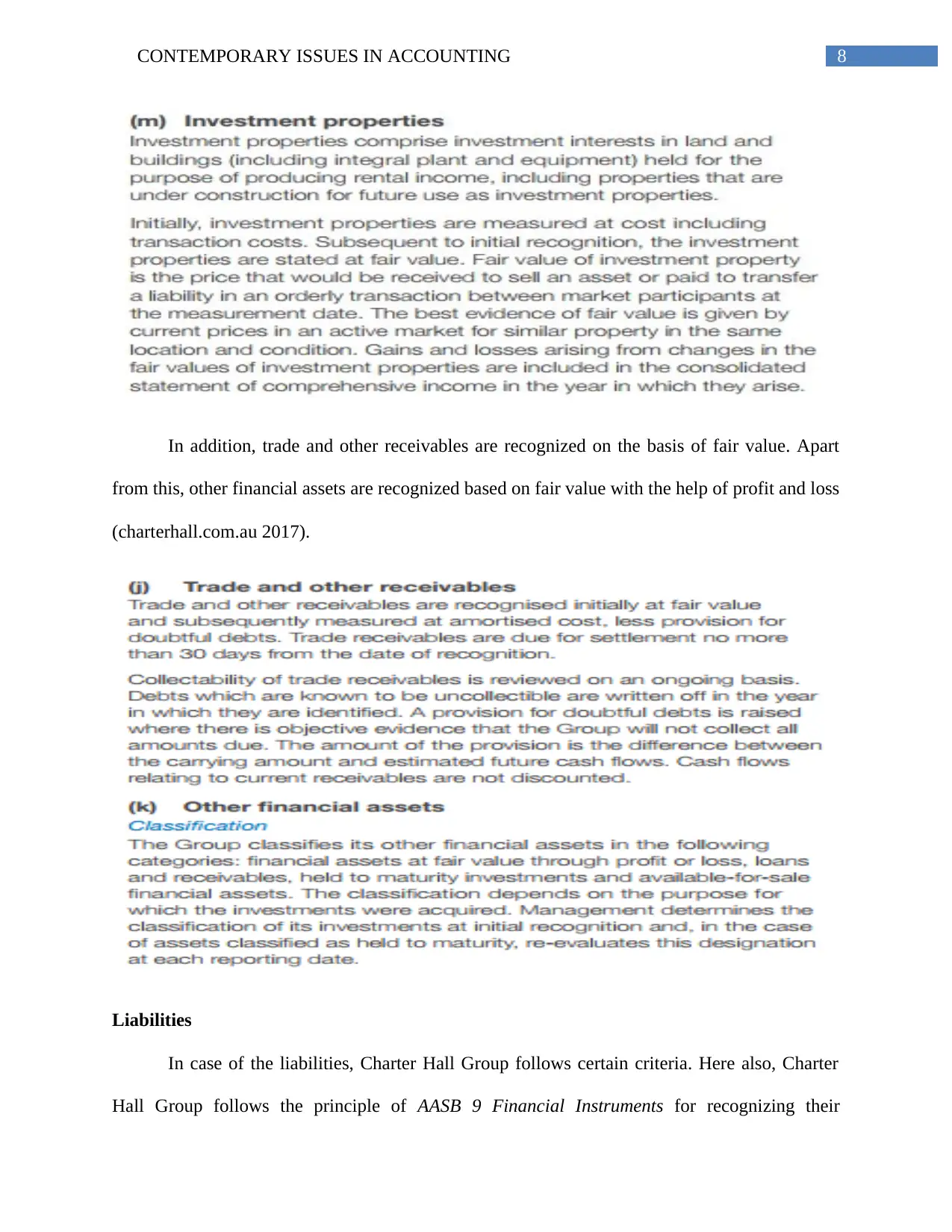
8CONTEMPORARY ISSUES IN ACCOUNTING
In addition, trade and other receivables are recognized on the basis of fair value. Apart
from this, other financial assets are recognized based on fair value with the help of profit and loss
(charterhall.com.au 2017).
Liabilities
In case of the liabilities, Charter Hall Group follows certain criteria. Here also, Charter
Hall Group follows the principle of AASB 9 Financial Instruments for recognizing their
In addition, trade and other receivables are recognized on the basis of fair value. Apart
from this, other financial assets are recognized based on fair value with the help of profit and loss
(charterhall.com.au 2017).
Liabilities
In case of the liabilities, Charter Hall Group follows certain criteria. Here also, Charter
Hall Group follows the principle of AASB 9 Financial Instruments for recognizing their
⊘ This is a preview!⊘
Do you want full access?
Subscribe today to unlock all pages.

Trusted by 1+ million students worldwide
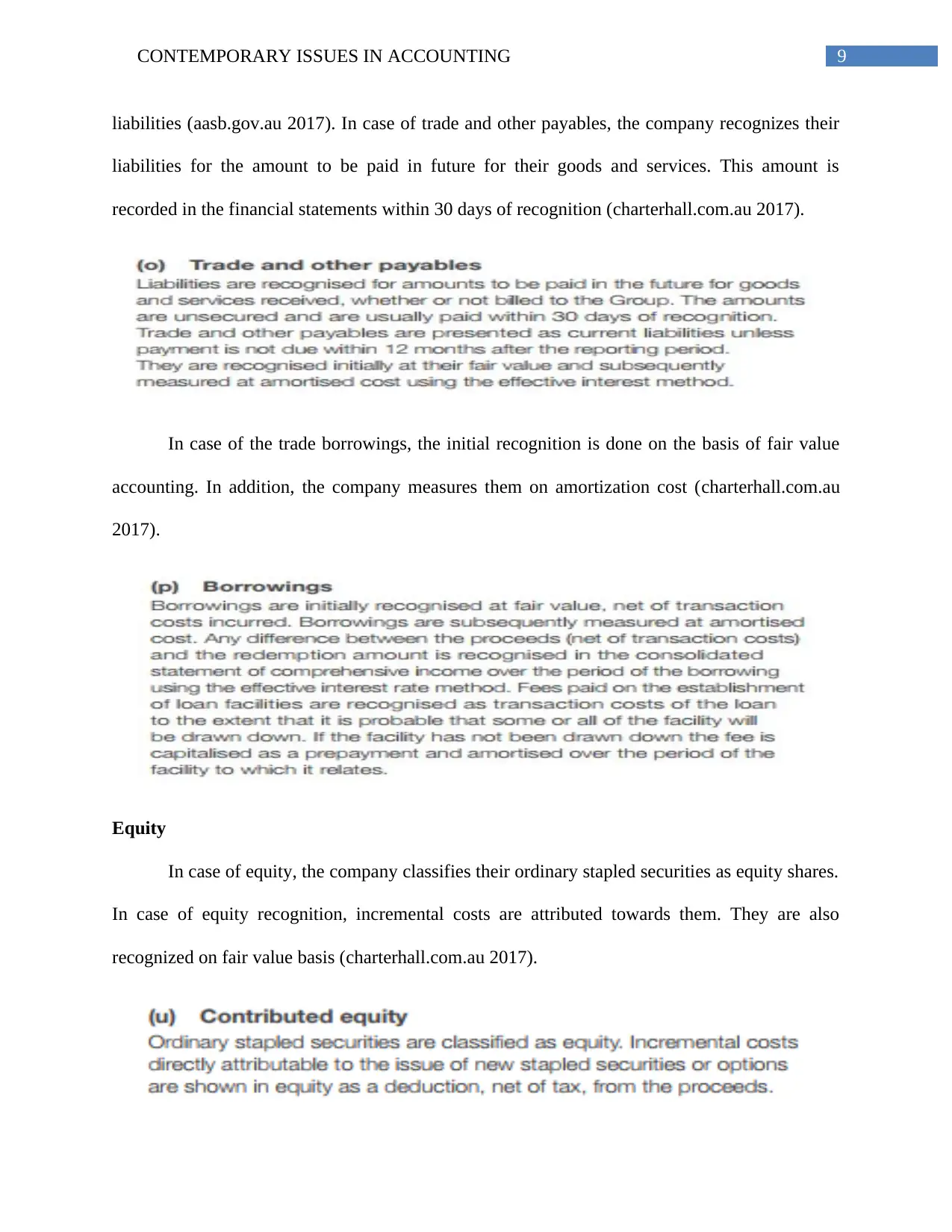
9CONTEMPORARY ISSUES IN ACCOUNTING
liabilities (aasb.gov.au 2017). In case of trade and other payables, the company recognizes their
liabilities for the amount to be paid in future for their goods and services. This amount is
recorded in the financial statements within 30 days of recognition (charterhall.com.au 2017).
In case of the trade borrowings, the initial recognition is done on the basis of fair value
accounting. In addition, the company measures them on amortization cost (charterhall.com.au
2017).
Equity
In case of equity, the company classifies their ordinary stapled securities as equity shares.
In case of equity recognition, incremental costs are attributed towards them. They are also
recognized on fair value basis (charterhall.com.au 2017).
liabilities (aasb.gov.au 2017). In case of trade and other payables, the company recognizes their
liabilities for the amount to be paid in future for their goods and services. This amount is
recorded in the financial statements within 30 days of recognition (charterhall.com.au 2017).
In case of the trade borrowings, the initial recognition is done on the basis of fair value
accounting. In addition, the company measures them on amortization cost (charterhall.com.au
2017).
Equity
In case of equity, the company classifies their ordinary stapled securities as equity shares.
In case of equity recognition, incremental costs are attributed towards them. They are also
recognized on fair value basis (charterhall.com.au 2017).
Paraphrase This Document
Need a fresh take? Get an instant paraphrase of this document with our AI Paraphraser
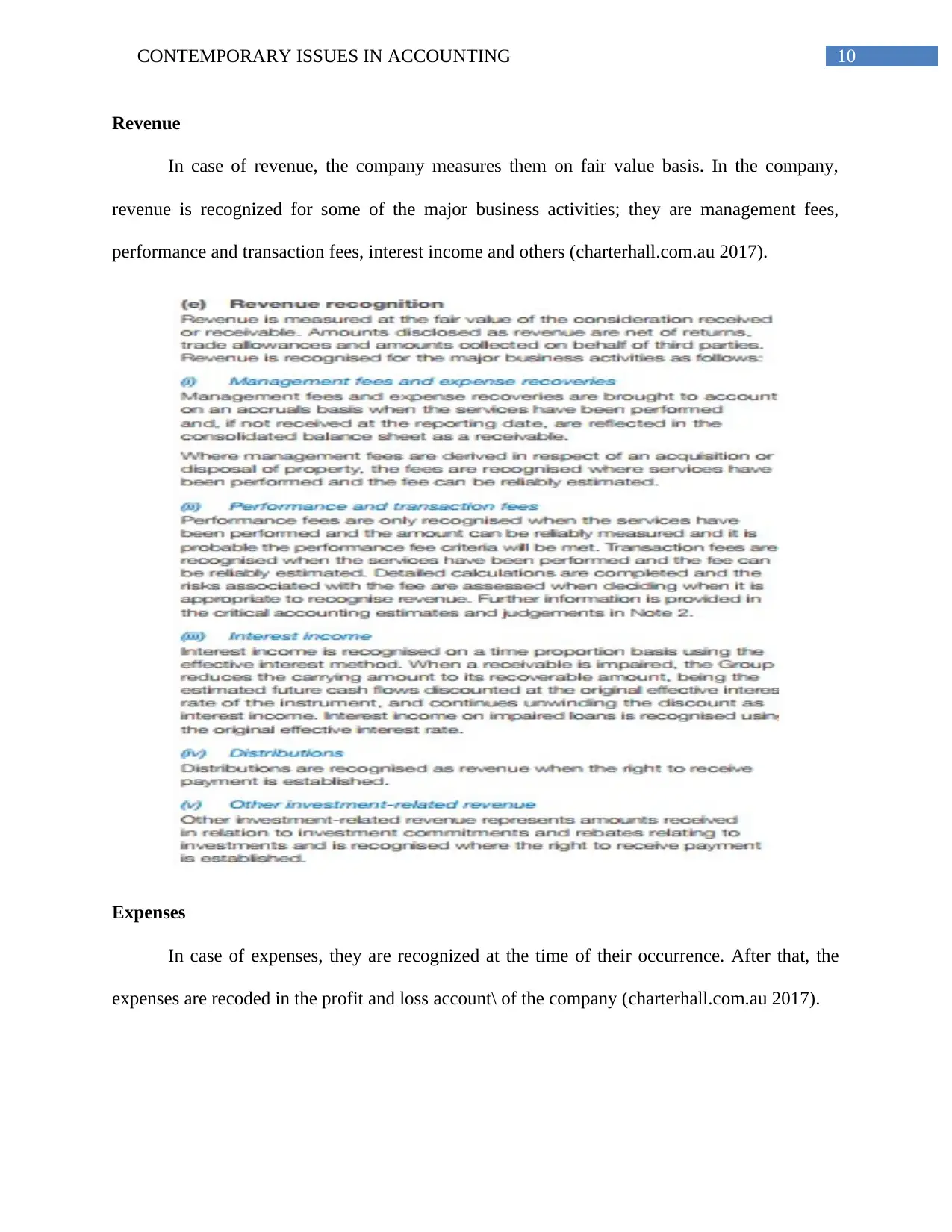
10CONTEMPORARY ISSUES IN ACCOUNTING
Revenue
In case of revenue, the company measures them on fair value basis. In the company,
revenue is recognized for some of the major business activities; they are management fees,
performance and transaction fees, interest income and others (charterhall.com.au 2017).
Expenses
In case of expenses, they are recognized at the time of their occurrence. After that, the
expenses are recoded in the profit and loss account\ of the company (charterhall.com.au 2017).
Revenue
In case of revenue, the company measures them on fair value basis. In the company,
revenue is recognized for some of the major business activities; they are management fees,
performance and transaction fees, interest income and others (charterhall.com.au 2017).
Expenses
In case of expenses, they are recognized at the time of their occurrence. After that, the
expenses are recoded in the profit and loss account\ of the company (charterhall.com.au 2017).
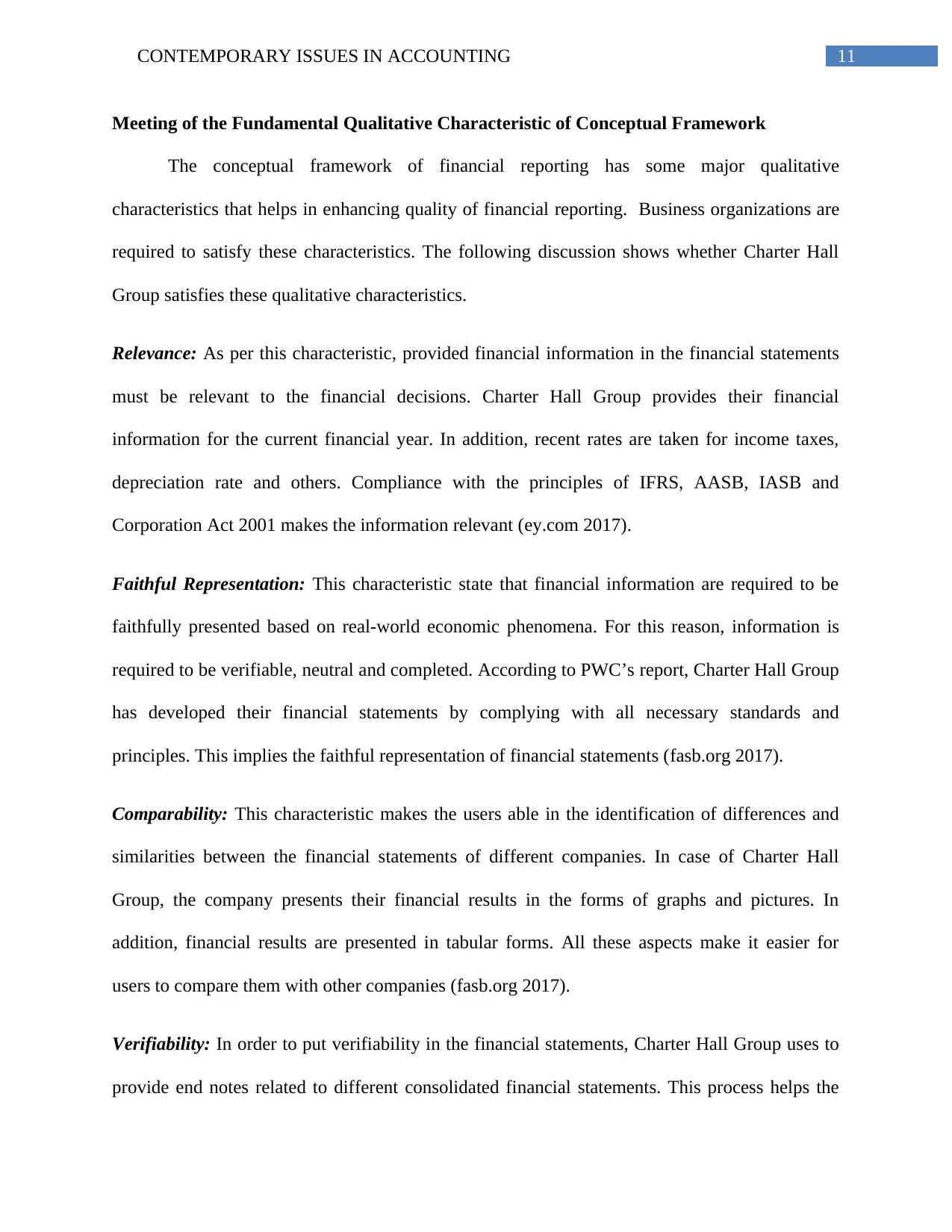
11CONTEMPORARY ISSUES IN ACCOUNTING
Meeting of the Fundamental Qualitative Characteristic of Conceptual Framework
The conceptual framework of financial reporting has some major qualitative
characteristics that helps in enhancing quality of financial reporting. Business organizations are
required to satisfy these characteristics. The following discussion shows whether Charter Hall
Group satisfies these qualitative characteristics.
Relevance: As per this characteristic, provided financial information in the financial statements
must be relevant to the financial decisions. Charter Hall Group provides their financial
information for the current financial year. In addition, recent rates are taken for income taxes,
depreciation rate and others. Compliance with the principles of IFRS, AASB, IASB and
Corporation Act 2001 makes the information relevant (ey.com 2017).
Faithful Representation: This characteristic state that financial information are required to be
faithfully presented based on real-world economic phenomena. For this reason, information is
required to be verifiable, neutral and completed. According to PWC’s report, Charter Hall Group
has developed their financial statements by complying with all necessary standards and
principles. This implies the faithful representation of financial statements (fasb.org 2017).
Comparability: This characteristic makes the users able in the identification of differences and
similarities between the financial statements of different companies. In case of Charter Hall
Group, the company presents their financial results in the forms of graphs and pictures. In
addition, financial results are presented in tabular forms. All these aspects make it easier for
users to compare them with other companies (fasb.org 2017).
Verifiability: In order to put verifiability in the financial statements, Charter Hall Group uses to
provide end notes related to different consolidated financial statements. This process helps the
Meeting of the Fundamental Qualitative Characteristic of Conceptual Framework
The conceptual framework of financial reporting has some major qualitative
characteristics that helps in enhancing quality of financial reporting. Business organizations are
required to satisfy these characteristics. The following discussion shows whether Charter Hall
Group satisfies these qualitative characteristics.
Relevance: As per this characteristic, provided financial information in the financial statements
must be relevant to the financial decisions. Charter Hall Group provides their financial
information for the current financial year. In addition, recent rates are taken for income taxes,
depreciation rate and others. Compliance with the principles of IFRS, AASB, IASB and
Corporation Act 2001 makes the information relevant (ey.com 2017).
Faithful Representation: This characteristic state that financial information are required to be
faithfully presented based on real-world economic phenomena. For this reason, information is
required to be verifiable, neutral and completed. According to PWC’s report, Charter Hall Group
has developed their financial statements by complying with all necessary standards and
principles. This implies the faithful representation of financial statements (fasb.org 2017).
Comparability: This characteristic makes the users able in the identification of differences and
similarities between the financial statements of different companies. In case of Charter Hall
Group, the company presents their financial results in the forms of graphs and pictures. In
addition, financial results are presented in tabular forms. All these aspects make it easier for
users to compare them with other companies (fasb.org 2017).
Verifiability: In order to put verifiability in the financial statements, Charter Hall Group uses to
provide end notes related to different consolidated financial statements. This process helps the
⊘ This is a preview!⊘
Do you want full access?
Subscribe today to unlock all pages.

Trusted by 1+ million students worldwide
1 out of 16
Related Documents
Your All-in-One AI-Powered Toolkit for Academic Success.
+13062052269
info@desklib.com
Available 24*7 on WhatsApp / Email
![[object Object]](/_next/static/media/star-bottom.7253800d.svg)
Unlock your academic potential
Copyright © 2020–2025 A2Z Services. All Rights Reserved. Developed and managed by ZUCOL.




